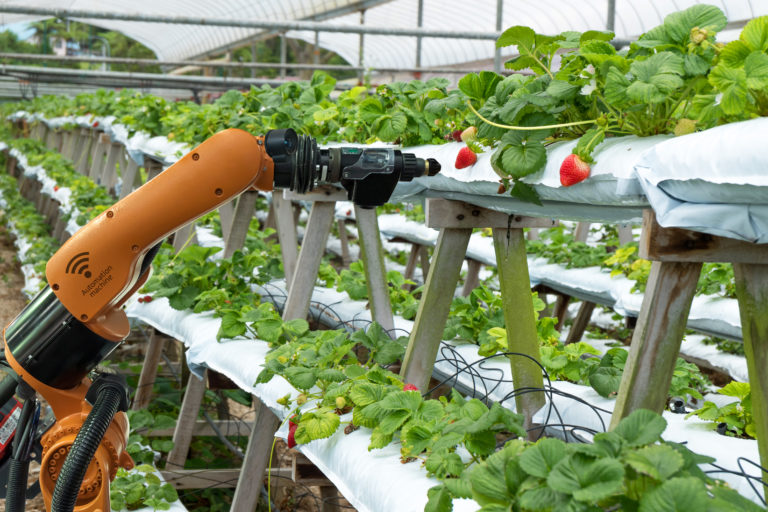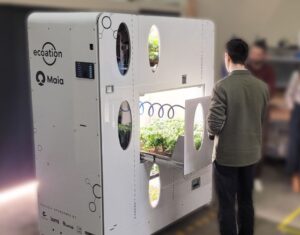Farm Robotics startups are a captivating segment of the agrifood technology sector, partly because robots are fascinating to watch, but also because the problems they solve are pressing, not least the issue of labor.
“We can import labor, or we can import our fruits and vegetables,” said John Oxford of the Produce Marketing Association at a congressional hearing in May of 2016. The dearth of agricultural labor is a continuing issue on both sides of the Atlantic. Political uncertainty on the US side is causing the supply of both legal and illegal migrant workers to dry up, and the falling value of Sterling against the Euro in light of Brexit has led to similar problems in the UK.
“The [workers] that are here are just not enough for what we need to harvest. This political instability has made our region suffer a lot when it comes to harvesting the food that we eat,” said grower Javier Zamura on stage at the Forbes Agtech Summit in June.
But replacing human hands with robots in ever-changing, inconsistent, outdoor environments is easier said than done. It is tempting to compare a farm to a factory with so many complicated products now manufactured completed devoid of physical human interaction, but both growers and field robotics entrepreneurs agree that integrating robots into fieldwork is much more difficult.
“Traditional robots were designed to perform very specific tasks over and over again. But the robots that will be used in food and agricultural applications will have to be much more flexible than what we’ve seen in automotive manufacturing plants in order to deal with natural variation in food products or the outdoor environment. This means farm robotics startups have to design systems from the ground up, which can take time and money, and their robots have to be able to complete multiple tasks to avoid sitting on the shelf for a significant portion of the year,” Dan Harburg of Dutch agtech venture capital firm Anterra Capital told AgFunderNews.
Labor is not the only pressing issue farm robotics startups stand to solve; the potential for precision agriculture and the resulting reduction in use of inputs such as chemicals and other natural resources is another exciting potential for the technology.
Farm Robotics Startups Scarcity
In the first half of 2017, investment in Robotics, Equipment and Mechanization startups declined year-over-year, according to AgFunder data, and deals have been scarce since. But one big event in the summer turned the heads of many investors and changed the narrative for farm robotics in 2017: John Deere’s purchase of “see and spray” weeding robotics company Blue River Technologies for $305 million.
Blue River has developed farm robotics using computer vision that can see, diagnose, and execute actions such as deciding to spray a weed with herbicide — avoiding the crop — or to thin the crop. Just this summer, the company released its “See & Spray” weed control machine.
Blue River last raised funding at Series B stage in a $17 million round led by Pontifax AgTech, joined by Monsanto Growth Ventures (MGV), Syngenta Ventures, and existing investors Khosla Ventures, Data Collective Venture Capital, and Eric Schmidt’s Innovation Endeavors.
Though many in the industry are still sussing out what the purchase of the six-year-old startup signals for the future, experts say that the deal is likely a sign of things to come.
“I think there is a tipping point now in the robotics industry because several big players are looking at that business now. Big engineering and equipment companies from Asia are considering that sector and we may see other exits like we’ve seen with Blue River — some quick exits,” said Eric Marty of Emertec Gestion, an 18-year-old cleantech venture capital firm that has turned its attention to agrifood technology in the last decade.
The acquisition was a way for John Deere to purchase an entire robotics team as well as a saleable technology and since innovation in large agriculture corporates is difficult to foster due to the structure and slow decision-making of large multinationals, corporates may end up taking a similar tack to John Deere.
“Many of the large agricultural technology companies recognize that robotics and artificial intelligence will become ubiquitous across different types of equipment in the future. That is driving them to rethink the processes by which they bring new products to market and the composition of the software and hardware teams. John Deere clearly understood this trend and was an early mover in bringing on a very talented team with a proven product. I wouldn’t be surprised if others follow suit,” said Harburg.
Several industry experts suggested that M&A will be a large part of the future of robotics, but the deals may look nothing like the Blue River acquisition.
“It is a very fragmented sector with a lot of small companies with specific IP. There is definitely an acceleration in M&A coming,” said Bénédicte Monpert of European agtech VC Capagro, suggesting that the future of farm robotics may be built by combining startups that offer segmented capabilities, rather than a complete robot.
Marty said that startups need to focus on their core value to an acquirer and this may not be a functioning robot in many cases, but exceptional capabilities that could contribute to one.
“Are [potential acquirers] going to buy the mechanics? Or are they going to buy the intelligence that is inside the robot? This remains a question and according to which kind of people you are talking with, you may have different answers,” said Marty.
Most farm robotics startups fall into three categories: spraying and weeding, harvesting, and controlled environment agriculture.
Seeding and Weeding
Pre-harvest field robotics is perhaps the most mature segment of the farm robotics startups space, though it is still quite nascent with robots still in development and many not at full commercial scale. Though the founders of these startups tell us that robotic solutions to seasonal, difficult, and dangerous jobs are in demand from farmers, the industry needed more progress in capabilities like machine learning and computer vision before farm robotics startups could bring the precision and utility farmers expect.
“We started with this vision of weeding, and I’ll tell you what, when we started the company in 2011, a lot of the techniques that now exist didn’t exist,” Jorge Heraud, CEO of Blue River Technologies told AgFunderNews pointing to machine learning and deep learning, which are still nascent tools today. Heraud said that building capacity in lettuce thinning eventually led the company to be more prepared to transition to weeding when the other necessary technologies caught up.
Spraying and weeding robots not only look to remove a tedious task from a grower’s to-do list, but also claim to drastically decrease the amount of pesticide that needs to be sprayed as a result of precise targeting — leading to decreased expenses for the farmer, a safer product for consumers, and healthier soil. Blue River claims it can reduce agrochemical use by 90%.
Other weeding robotics companies include France’s Naio Technologies, which uses laser and camera guidance to move autonomously between rows of fruits and vegetables and can recognize different types of plants to identify weeds. Naio has raised €3.5 million ($4.1 million), mostly from European investors such as Capagro and Emertec Gestion.
Also in this category is Switzerland’s ecoRobotix, a robot weeder manufacturer targeting row crops, which has raised $3 million from early stage Swiss risk capital fund 4FO Ventures.
On the planting side is Spain’s PlantTape, which has developed a plant transplanting robot. The company says the system is more efficient than the conventional transplanting methods using plugs and soil blocks and that it offers a fully integrated system from sowing the tape, to germination and nursery care, to transplanting in the field. PlantTape is commercially used to plant lettuces, broccoli, cauliflower, celery, onions, tomatoes, cabbage with other crops are currently on trial.
Harvesting
Harvesting of row crops has been automated for decades, but harvesting of specialty crops, like nuts, fruits, and vegetables, remains an elusive skill for farm robotics startups. Not only do these crops vary greatly in size, height , and color, they can also be more delicate and require not just a light touch in picking, but immediate assessment and packing by size or quality.
“It’s gotta replace the person that’s gonna pick up that head [of lettuce], know what size it is, know how dense it should be, peel the delicate leaves off it, decide what box it should go in, wrap it in a bag, tape it, and make it presentable to the store. That’s the hardest piece right now. We’ve made a lot of progress, from planting to cutting, but it kind of stops at cutting,” said Brain Antle, harvest manager for lettuce and vegetable grower Tanimura & Antle at the Forbes Agtech Summit in June.
So far farm robotics startups are making progress with a few types of fruit including Abundant Robotics, which has developed an apple-picking robot. Abundant robotics has raised $12 million in two rounds from a wide variety of investors from GV (Google Ventures), BayWa, the German agricultural trading and logistics company, Tellus Partners, the agribusiness private equity firm, Yamaha Motor Ventures, and robotics VC KPCB Edge. Also in this category are strawberry picking robotics companies Agrobot and Harvest Croo.
Controlled Environment Agriculture
Though not technically in the fields, controlled environment agriculture (CEA) is ripe for robotics intervention because the same factors that make harvests more predictable, make necessary tasks more repetitive and less complicated by forces like uneven surfaces and weather.
Spread is a Japanese indoor vertical farming company that will open an automated lettuce farm in early 2018 allowing for a 50% reduction in human labor, according to the company. Transplanting seedlings, managing the growth process, and harvesting will all be automated, according to the company’s website.
Tortuga AgTech is deploying robotics in controlled environments for horticulture production, and Harvest Automation’s nursery robot moves potted nursery plants and rootstock for orchards within a greenhouse.
Though we have yet to see robotics vendors specifically targeting the high-tech hydroponic and aeroponic players within CEA, South San Francisco-based vertical farm Plenty’s CEO told Business Insider that the company uses tiny robots in its seeding process.
In another area of CEA altogether, Ynsect told AgFunderNews it is also using robotics to produce mealworm at its pilot center in Jura, France.
















Sponsored
International Fresh Produce Association launches year 3 of its produce accelerator